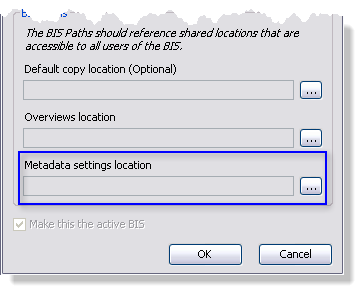ArcGIS for Maritime: Bathymetry allows you to add new metadata fields to or retire existing metadata fields from the Manage Collections and Add Bathymetry dialog boxes and the Explore Bathymetry and Compose Surface windows. In addition to adding and retiring fields, you can append a new selection to a drop-down menu and add validation rules to ensure the metadata values meet your business rule requirements.
There are three types of metadata associated with bathymetry in the BIS geodatabase:
- Collection—Defines the necessary attributes for a collection of bathymetry data. A collection could consist of all bathymetry data holdings in a common geographic area, represent the bathymetric data acquired during a survey, or any other logical grouping of datasets that is defined by your organization. The detailed information on the collection can be linked to bathymetric datasets registered with the BIS geodatabase.
- Extended—Allows you to associate metadata to raster and point datasets that have been registered with the BIS database. By default, you will have IHO Survey Order, Sensor make and model, Vessel, and Data type available to you as example fields, but these entries can be customized or replaced with more applicable fields to meet your organization's needs. For example, you can add fields that define which Multibeam echo sounding equipment was used on a specific vessel.
- Internal—The internal metadata allows for Bathymetric Attributed Grids (BAG) to be registered with the BIS geodatabase and catalogs the metadata standard to the BAG format. For example, in the case of a BAG file, the ONS (internal) metadata adheres to the ISO 19115 geographic metadata standard and is stored within each BAG dataset. Since these fields are part of a metadata standard, you don’t have all the customization options as you do with the collection and extended metadata fields.
The metadata fields appear in the following dialog boxes and windows:
- Add Bathymetry dialog box
- Manage Collections dialog box
- Explore Bathymetry window
- Compose Surface window
Collection and extended metadata fields and drop-down items available in these dialog boxes and windows are completely configurable within BIS metadata XML files; that is, you can restore or retire fields, you can add a new metadata field, or you can add a new item to an existing metadata field. This can all be done using the Metadata Configuration Editor dialog box available from the Manage BIS Settings window. Alternatively, you may also make edits to the collection or extended metadata schema by modifying the XML files directly.
For internal metadata, you can make limited edits such as restoring or retiring fields from the dialog boxes and windows. Internal metadata must adhere to the standard applicable to the datasets registered with the BIS. As BAG datasets are the only format that honor internal metadata, the internal metadata must conform to ONS metadata standard ISO 19115; therefore, you cannot add a custom metadata field or update the metadata field definitions as you might with the collection and extended metadata fields.
Learn more about internal metadata configuration within the ONS BAG dataset
XML files can be found in the metadata settings location, which you define on the Create BIS Database dialog box.

These XML files include:
- BisCollectionExtMetadataDef—Controls the Collection Metadata field display within the Manage Collections and Add Bathymetry dialog boxes and the Explore Bathymetry and Compose Surface windows.
- BisDatasetExtMetadataDef—Controls the Extended Metadata field display within the Add Bathymetry dialog box and the Explore Bathymetry and Compose Surface windows. This metadata file should be edited to include the appropriate fields for your organization.
- ONSBagInternalMetadataDef—Controls the Internal Metadata field display within the Add Bathymetry dialog box and the Explore Bathymetry and Compose Surface windows.